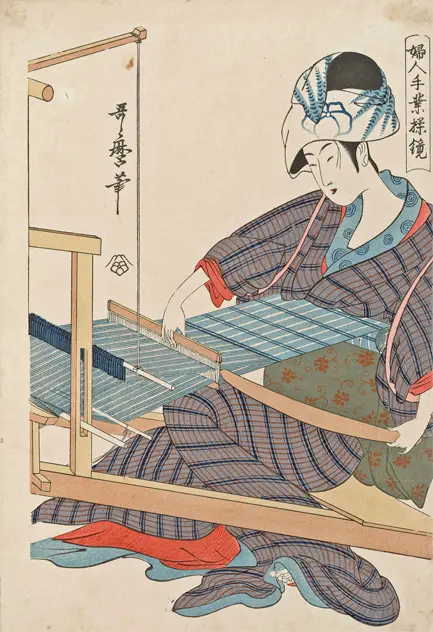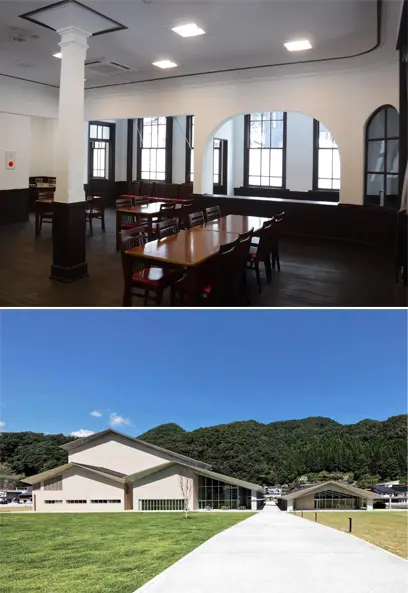
One of the prints from the Gunze Collection on loan to the exhibition.
"Fujin tewaza ayatsuri kagami" by Kitagawa Utamaro.
About GUNZE
Business
Research & Development
Sustainability
Investor Relations
Osaka-Gunze Limited (Headquarters: Osaka, Japan, President: Toshiyasu Saguchi) [TOKYO: 3002] is pleased to announce that the Gunze Museum in Ayabe City, Kyoto, the birthplace of the company, is lending seven ukiyo-e prints from the Gunze ukiyo-e collection for a "Special Exhibition of Silk Manufacturing Industry in Ukiyo-e" to be held at the Exhibition Hall of the Yabu City Civic Exchange Square from February 21 to March 12, 2023.
Gunze and Yabu City have a long history. It began operations in 1914 as Yabu Silk Factory, and after several changes of business type, continued until it closed as G M Electronics in 2009. The office and its former site are now used as the Yabu City Civic Exchange Square (nicknamed YB Fab). You can get a glimpse of its history at "From Gunze Yoka Factory to YB Fab," which will be held concurrently with the event.
Gunze actively participates in social and community activities, building friendly relationships with society and pursuing sustainability with local communities. In this way, the company strives to promote mutual development and prosperity.

One of the prints from the Gunze Collection on loan to the exhibition.
"Fujin tewaza ayatsuri kagami" by Kitagawa Utamaro.
Ukiyo-e is a type of Japanese woodblock print that was popular from the Edo period to the Meiji period, many ukiyo-e prints were created to depict the lifestyle, customs and fashions of the time, with nishiki-e, or multi-coloured woodblock prints, being particularly popular with people. This exhibition featured prints by artists such as Kitagawa Utamaro, famous for his paintings of beautiful women, Utagawa Hiroshige, who painted the 53 stages of the Tokaido, and Yoshu Chikanobu, known as the last ukiyo-e artist of the Meiji period.
Enjoy the variety of motifs such as scenes of sericulture in the Edo period, female sericulture workers at the Imperial Court, the god of sericulture, the seven gods of good fortune and colourful and splendid depictions.

(over) “Free Room in Plaze”, a renovated office of the former Gunze Yoka Factory
(under)”Yabu Citizens Exchange Plaza" built on the former factory site.
(Image courtesy of Yabu City)
This is a panel exhibition showing the history of Gunze Yoka Factory and its photos.
Established in the Meiji era, Gunze Yoka Factory became Gunze Yoka Factory in the Taisho era and closed its doors in the war and post-war period after G.M. Electronics in 2009. In the mid Showa period, many factory girls worked there and also studied at a women's school. The history and conditions of the Gunze Yoka factory are explained with the help of some photographs and other materials.
Gunze was founded in 1896 by Tsurukichi Hatano in Ikaruga Ward (now Ayabe City) to promote the local silkworm industry. The founder had an enthusiastic determination to contribute to the development of his hometown community by promoting the local silk industry. He believed that this should serve as Ikaruga's policy, so he named his company Gunze Silk Manufacturing Co., Ltd. (later renamed Gunze Limited), with "Gunze" meaning "district policy" in Japanese. Today, Gunze is a leading designer and manufacturer of plastic films, engineering plastics, medical devices, electronic components, apparel and other products. Gunze employs more than 5,600 people in 10 countries around the world.
Gunze Limited
Corporate Communication Department
TEL: 81-6-6348-1314 (Shinji Nonaka)